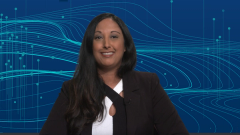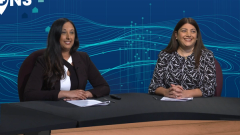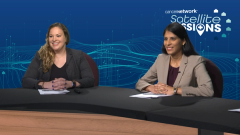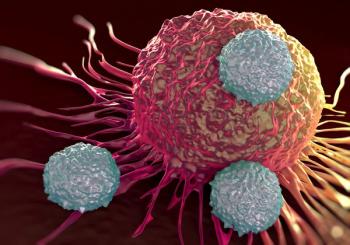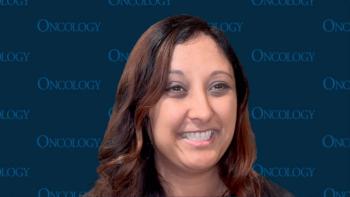
Induction Therapy for Transplant-Eligible Newly Diagnosed Multiple Myeloma
Expert panelists review available induction therapy regimens for patients newly diagnosed with transplant-eligible multiple myeloma in the context of clinical data.
Episodes in this series

Transcript:
Krina K. Patel, MD, MSc: Hello and welcome to this CancerNetwork® Satellite Sessions program titled, “Treatment of Multiple Myeloma: Best Practices From the MD Anderson Cancer Center and Satellites.” I’m Krina Patel, associate professor in the department of lymphoma and myeloma at the University of Texas MD Anderson Cancer Center in Houston. Today, I’m joined by a panel of physicians from satellite clinics of MD Anderson, as well as the main campus, who treat patients with multiple myeloma. I’d like to welcome my esteemed fellow panelists to introduce themselves.
Sairah Ahmed, MD: My name is Sairah Ahmed. I’m an associate professor in the department of lymphoma and myeloma, and I’m the director of the CAR [chimeric antigen receptor] T-cell therapy program.
Tejo N. Musunuru, MD: I’m Dr Musunuru. I’m one of the assistant professors in the department of general oncology, and I work at the League City, Houston area location for MD Anderson.
Melody R. Becnel, MD: Hi, and I’m Dr Melody Becnel. I am one of the assistant professors in the department of lymphoma and myeloma.
Krina K. Patel, MD, MSc: Perfect. We have some powerful women here today for you. Welcome everyone, and thank you for joining me. Today, we’re going to review a number of recent updates in the treatment of multiple myeloma, and we’ll discuss how physicians at MD Anderson’s main clinic and satellite locations apply evidence to clinical practice. Additionally, we will focus on how the main institution works with the satellite clinics to improve patient outcomes. With that, let’s get started on our first topic. We’ve had so many changes recently in newly diagnosed myeloma, and we’ve had some great outcome changes. Dr Becnel, do you want to talk about triplet and now quadruplet induction regimens that we tend to use for possible transplant-eligible patients?
Melody R. Becnel, MD: Yes. At this point, when it comes to picking induction therapy for our patients, it’s a bit more challenging than it used to be. We’re having to individualize that according to patient comorbidities, risk factors for high-risk myeloma, etc. So, when it comes to picking triplets versus quads in the induction setting, I’m pretty much going with quads for my younger, fit patients who are especially high risk. For patients who are maybe less fit, I’m still going to go with triplets for sure, but depending on how they do, we may change that in the future. I think for me it’s more for high-risk, fit [patients], I’m probably going with quad therapy.
Krina K. Patel, MD, MSc: What about you, Dr Musunuru? What do you do in the satellites?
Tejo N. Musunuru, MD: We are doing pretty much the same thing, which is the risk stratification based on their disease as well as the patient comorbidities. These are the major reasons to choose one regimen over the other. The choice of the triplet or the quadruplet is now a dealer’s choice. As she just mentioned, it used to be so much easier, but catching up with the new trends has become difficult in the realm of myeloma. I still go with the patient comorbidities. The other one is a convenience thing. Some people would like an oral regimen, which now we’re starting to see them, not probably in the first line, but more in the second-line setting. One other thing about myeloma is whether they can come in every week. Despite all the advances in the treatment, we still have most of the regimens where they must come in about once a week. How comfortable are they doing that?
Krina K. Patel, MD, MSc: Sure. I think about transplant eligibility versus ineligibility, I come back and say, what does that really mean? When I first see a patient come to my clinic, sometimes I can’t tell if they’re eligible or not. So, it really is about trying to decide based on performance status and frailty, what can this patient start with? A lot of times I’ll start with the triplet and then, once I know they’re doing better, I’ll add the other drug. For instance, if we are using DARA-VRd [daratumumab with bortezomib, lenalidomide and dexamethasone], a lot of times we can’t get the lenalidomide right away, so we’ll start with the DARA-Vd and then order the lenalidomide and start it at a low dose for the fourth drug.
I agree with the frailty piece. I will say that for some of my patients, my goal really is to get that deep response at the beginning because we know that’s when they do the best. Sometimes, I do a quad, lower the doses, and maybe do it weekly instead of twice weekly for some of the regimens, for which we’ll go into more detail. But again, our goal is to get it down, and we know that patients then do better. Their quality of life goes up by managing their toxicity. I agree. It’s sort of a dealer’s choice, and it’s about when that patient comes in, but of course, our goal is still the same, to make sure we get them the best response with the least toxicity.
With that, I think it’s a perfect segue to the GRIFFIN study. At IMS [International Myeloma Society meeting] it was updated, and we had the last patient being 2 years out now after maintenance therapy, and [we saw] amazing response rates. The depth of response was over 60% in terms of MRD [minimal residual disease] negativity, and response rates around 90%. What do you think about that in its application now into our clinics?
Melody R. Becnel, MD: DARA-VRd I think is probably my go-to in terms of my quad induction for most patients. When it comes to maintenance daratumumab, I am doing that in lots of patients. I think it does lead to significantly improved outcomes. From a convenience perspective, it’s so well tolerated. I do give patients the options, but I think most patients are picking to do it.
Krina K. Patel, MD, MSc: What about you for maintenance?
Tejo N. Musunuru, MD: That is my experience too. DARA-VRd is my go-to regimen for the quads. As you mentioned, getting Revlimid [lenalidomide] early may be a little difficult, so I might skip the first cycle sometimes just to get them started on treatment, and then I go on to the quad. I have been doing daratumumab maintenance just because of the convenience. Compared to things like Kyprolis or Velcade, with the neuropathy and all the cardiac issues that are involved with the other drugs, I’ve noticed that daratumumab is a lot easier on the patients compared to the other regimens. Same thing with the Revlimid maintenance, but for the high-risk patients, I’m usually going with the daratumumab and Revlimid.
Krina K. Patel, MD, MSc: I think that’s perfect because I don’t do daratumumab and Revlimid for everybody. Again, post-transplant, if they’ve had a great response, I still want to make sure they don’t get infections, so I’ll start slow. For high-risk patients, where I want to give at least a doublet or even a triplet maintenance, it goes to once a month. What patient doesn’t love only having to come in once a month?
Tejo N. Musunuru, MD: I had a patient yesterday who was in the third cycle. You just have to come in once every 2 weeks and they said, “Oh, wow.” I said 2 more cycles and you go to once a month, and they said, “Oh my God, this is amazing.”
Krina K. Patel, MD, MSc: Exactly. I think that regimen is very patient-friendly and again, knocking that myeloma down in different ways. The other thing we talk about in high risk is Kyprolis, or carfilzomib, instead of the bortezomib. The MASTER study was also presented by our friend [Luciano] Costa, [MD, PhD,] and it’s DARA-KRd [daratumumab with carfilzomib, lenalidomide, dexamethasone]. This trial looked at the depth of response. That was awesome, for the first time in myeloma, we were able to look at MRD. Most of us are millennials, I think. We don’t want to wait for that overall survival; the PFS [progression-free survival] is way too long to wait for. So, having something as a surrogate, like MRD, is pretty fantastic. I think the data showed that the patients who are standard risk who get to MRD negativity, and you have to have 2 negative MRD [results]. Then you can stop all maintenance after you do your initial quadruplet with the daratumumab with carfilzomib, lenalidomide, dexamethasone. Then you do transplant maintenance, and you can stop it. But what we learned is information on the high-risk patients. What do you think about that?
Melody R. Becnel, MD: I think in high-risk patients, it gives me a little concern to stop maintenance.
Krina K. Patel, MD, MSc: Because they relapse earlier, especially with the 2 cytogenetic risks.
Melody R. Becnel, MD: I do love DARA-KRd as the quad regimen, especially if they’re super high risk, based off some of the data you just mentioned. You do have to be fit for that in particular. I notice a bit more fatigue with that regimen, but I agree, I think the responses we’re getting are fantastic. For high risk, I would probably still do a maintenance approach of something even with 2 negative MRDs.
Krina K. Patel, MD, MSc: Any thoughts on your maintenance regimens that you tend to use?
Melody R. Becnel, MD: For high-risk patients, I still like to include a PI [proteasome inhibitor] for some component of it, so it depends on the patient. Occasionally, if a patient tells me they absolutely are done with infusions or injections, I will do IRd [ixazomib, lenalidomide, dexamethasone].
Krina K. Patel, MD, MSc: More for convenience.
Melody R. Becnel, MD: Yes, more for convenience, but I think a lot of patients will prefer the Velcade and Revlimid option. Daratumumab with Revlimid is also OK for high risk, so as long as we’re doing 2 agents, I’m OK with that.
Krina K. Patel, MD, MSc: Perfect. Dr Musunuru, any other thoughts?
Tejo N. Musunuru, MD: Like I mentioned before, I usually go with the daratumumab and Revlimid just for the convenience of not having the weekly injections. It goes down to monthly, and it’s also well tolerated compared to the Velcade or carfilzomib. That’s the only reason I lean more toward the daratumumab and Revlimid for the high-risk patients. For the low-risk patients, I might just do the Revlimid maintenance. That’s usually my go-to.
Krina K. Patel, MD, MSc: Got it, perfect.
Transcript edited for clarity.
Newsletter
Stay up to date on recent advances in the multidisciplinary approach to cancer.


